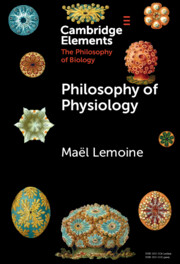Refine search
Actions for selected content:
210 results
Introduction
-
- Book:
- Galen on Human Physiology
- Published online:
- 28 July 2025
- Print publication:
- 02 October 2025, pp 1-21
-
- Chapter
- Export citation
The lower cavity: the origins and history of an anatomical idea
-
- Journal:
- Medical History , First View
- Published online by Cambridge University Press:
- 06 August 2025, pp. 1-19
-
- Article
-
- You have access
- Open access
- HTML
- Export citation

Galen on Human Physiology
- Taking the Body Apart and Putting it Back Together Again
-
- Published online:
- 28 July 2025
- Print publication:
- 02 October 2025
The saccule and gravity
-
- Journal:
- The Journal of Laryngology & Otology / Volume 139 / Issue 8 / August 2025
- Published online by Cambridge University Press:
- 23 June 2025, pp. 718-722
- Print publication:
- August 2025
-
- Article
- Export citation
Chapter 4 - Respiratory Regulation
-
-
- Book:
- Clinical Neurorespiratory Medicine
- Published online:
- 26 May 2025
- Print publication:
- 19 June 2025, pp 33-40
-
- Chapter
- Export citation
Chapter 3 - Anatomy and Physiology of the Lower Airways and the Lung
-
-
- Book:
- Clinical Neurorespiratory Medicine
- Published online:
- 26 May 2025
- Print publication:
- 19 June 2025, pp 23-32
-
- Chapter
- Export citation
Physiological response of Pygoscelis penguins in a rapidly changing region
- Part of
-
- Journal:
- Antarctic Science , First View
- Published online by Cambridge University Press:
- 18 June 2025, pp. 1-7
-
- Article
-
- You have access
- Open access
- HTML
- Export citation
1 - The Mismeasure of Sport
-
- Book:
- Gift and Grit
- Published online:
- 26 May 2025
- Print publication:
- 12 June 2025, pp 23-53
-
- Chapter
- Export citation
3 - Physiology
-
- Book:
- The Anaesthesia Science Viva Book
- Published online:
- 02 May 2025
- Print publication:
- 22 May 2025, pp 139-312
-
- Chapter
- Export citation
Silent middle ear dysfunction due to underlying laryngopharyngeal reflux disease: can it be reversed with anti-reflux therapy?
-
- Journal:
- The Journal of Laryngology & Otology , First View
- Published online by Cambridge University Press:
- 02 May 2025, pp. 1-7
-
- Article
- Export citation
Chapter 28 - Respiratory System: Anatomy
-
-
- Book:
- BASIC Essentials
- Published online:
- 21 February 2025
- Print publication:
- 13 March 2025, pp 154-157
-
- Chapter
- Export citation
Physiological reactions in plants visualized by 14C: The impact of sea spray on radiocarbon analyses of terrestrial plants in coastal regions quantified by a greenhouse study
-
- Journal:
- Radiocarbon / Volume 67 / Issue 3 / June 2025
- Published online by Cambridge University Press:
- 20 February 2025, pp. 539-564
- Print publication:
- June 2025
-
- Article
-
- You have access
- Open access
- HTML
- Export citation

Philosophy of Physiology
-
- Published online:
- 27 January 2025
- Print publication:
- 13 February 2025
-
- Element
- Export citation
15 - An Introduction to Bacteria
- from Part II - Single Bacteria
-
- Book:
- The Physics of Bacteria
- Published online:
- 12 December 2024
- Print publication:
- 19 December 2024, pp 145-163
-
- Chapter
- Export citation
Growth analysis of cassava genotypes planted under irrigation management practices during the early growth phase
-
- Journal:
- The Journal of Agricultural Science / Volume 162 / Issue 6 / December 2024
- Published online by Cambridge University Press:
- 12 December 2024, pp. 596-606
-
- Article
- Export citation
Chapter 23 - Colour Theory
- from Part IV - Philosophy and Science
-
-
- Book:
- Goethe in Context
- Published online:
- 16 May 2024
- Print publication:
- 23 May 2024, pp 225-233
-
- Chapter
- Export citation
The pioneers of vestibular physiology in the 19th century
-
- Journal:
- The Journal of Laryngology & Otology / Volume 138 / Issue 11 / November 2024
- Published online by Cambridge University Press:
- 08 May 2024, pp. 1108-1114
- Print publication:
- November 2024
-
- Article
- Export citation
8 - Colloid Fluids
- from Section 2 - Basic Science & Concepts in Fluid Therapy
-
-
- Book:
- Hemodynamic Monitoring and Fluid Therapy during Surgery
- Published online:
- 11 April 2024
- Print publication:
- 02 May 2024, pp 87-95
-
- Chapter
- Export citation
6 - Body Volumes and Fluid Kinetics
- from Section 2 - Basic Science & Concepts in Fluid Therapy
-
-
- Book:
- Hemodynamic Monitoring and Fluid Therapy during Surgery
- Published online:
- 11 April 2024
- Print publication:
- 02 May 2024, pp 67-76
-
- Chapter
- Export citation
Part I - What Is Cardiopulmonary Exercise Testing?
-
- Book:
- CPET Made Simple
- Published online:
- 04 April 2024
- Print publication:
- 11 April 2024, pp 3-24
-
- Chapter
- Export citation
